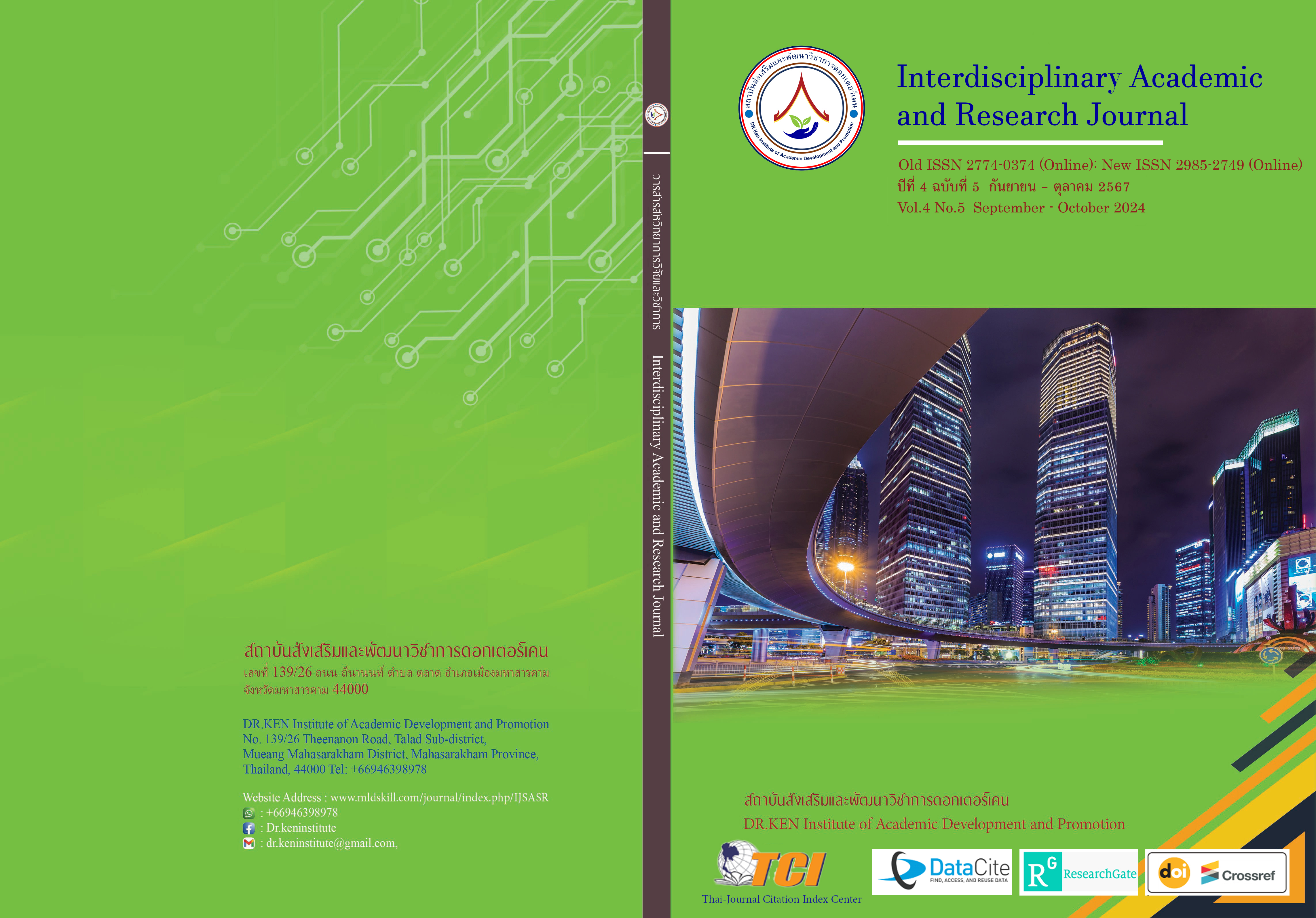การบริหารงานงบประมาณของโรงเรียนในสังกัดสำนักงานเขตพื้นที่การศึกษาประถมศึกษา นครราชสีมา เขต 4
DOI:
https://doi.org/10.60027/iarj.2024.276220คำสำคัญ:
การจัดทำงบประมาณ; , การบริหารงานงบประมาณ; , พัสดุ – ครุภัณฑ์บทคัดย่อ
ภูมิหลังและวัตถุประสงค์: การจัดทำงบประมาณในรูปแบบปัจจุบันเริ่มต้นขึ้นในประเทศอังกฤษประมาณคริสต์ศตวรรษที่ 16-17 ในช่วงเวลานั้น สภาผู้แทนราษฎรสามารถสงวนอำนาจในการอนุมัติรายได้และรายจ่ายของรัฐบาลได้สำเร็จ ซึ่งแสดงให้เห็นว่าการจัดทำงบประมาณในปัจจุบันมีความเกี่ยวข้องกับวิวัฒนาการของระบบการปกครอง ภายหลังการจัดทำงบประมาณนี้ได้ขยายไปยังองค์กรปกครองส่วนท้องถิ่น สถานศึกษา และหน่วยงานอื่น ๆ ทั้งภาครัฐและเอกชน การวิจัยนี้มีวัตถุประสงค์เพื่อศึกษาและเปรียบเทียบระดับความคิดเห็นของบุคลากรต่อการบริหารงานงบประมาณของโรงเรียนในสังกัดสำนักงานเขตพื้นที่การศึกษาประถมศึกษานครราชสีมา เขต 4 โดยจำแนกตามตำแหน่ง ขนาดโรงเรียน และประสบการณ์ในการปฏิบัติงาน รวมถึงการศึกษาแนวทางพัฒนาการบริหารงานงบประมาณของโรงเรียนในสังกัดดังกล่าวด้วย
ระเบียบวิธีการวิจัย: กลุ่มตัวอย่างที่ใช้ในการวิจัยประกอบด้วยผู้บริหารสถานศึกษาและหัวหน้ากลุ่มบริหารงบประมาณของสถานศึกษาในสังกัดสำนักงานเขตพื้นที่การศึกษาประถมศึกษานครราชสีมา เขต 4 จำนวน 196 คน ซึ่งได้รับการคัดเลือกด้วยวิธีการสุ่มแบบแบ่งชั้น เครื่องมือที่ใช้ในการวิจัย ได้แก่ แบบสอบถามที่มีมาตราส่วนประมาณค่า 5 ระดับ โดยมีค่า IOC อยู่ระหว่าง 0.80 – 1.00 และมีค่าความเชื่อมั่นเท่ากับ 0.85 นอกจากนี้ยังใช้แบบสัมภาษณ์ที่มีโครงสร้างเพื่อเก็บข้อมูลในการวิเคราะห์ข้อมูล ใช้สถิติต่าง ๆ ได้แก่ ความถี่ ร้อยละ ค่าเฉลี่ย ส่วนเบี่ยงเบนมาตรฐาน การทดสอบค่าที (t-test) และค่าเอฟ (F-test)
ผลการศึกษา: ผลการวิจัยมีดังนี้ (1) การบริหารงานงบประมาณของโรงเรียน ในสังกัดสำนักงานเขตพื้นที่การศึกษาประถมศึกษานครราชสีมา เขต 4 โดยรวมอยู่ในระดับมาก และเมื่อพิจารณาเป็นรายด้านพบว่าการบริหารงานงบประมาณมีระดับสูงในทุกด้าน (2) การวิเคราะห์เปรียบเทียบการบริหารงานงบประมาณ ของโรงเรียนในสังกัดสำนักงานเขตพื้นที่การศึกษาประถมศึกษานครราชสีมา เขต 4 พบว่ามีความแตกต่างกันอย่างมีนัยสำคัญทางสถิติที่ระดับ 0.05 เมื่อจำแนกตามตำแหน่ง แต่เมื่อจำแนกตามขนาดโรงเรียนและประสบการณ์ในการปฏิบัติงานไม่พบความแตกต่าง (3) แนวทางการบริหารงานงบประมาณ ของโรงเรียนในสังกัดสำนักงานเขตพื้นที่การศึกษาประถมศึกษานครราชสีมา เขต 4 ที่ควรดำเนินการประกอบด้วย การวิเคราะห์จุดแข็งและจุดอ่อน การจัดสรรงบประมาณอย่างเพียงพอและครอบคลุม การมีระบบตรวจสอบภายใน การจัดทำแผนระดมทุนและการใช้ทรัพยากรจากหน่วยงานภายนอกหรือผู้มีส่วนได้ส่วนเสีย รวมถึงการมีหลักฐานการรับเงินและการจ่าย การจัดทำบัญชีที่ถูกต้องตามระเบียบ และการรายงานข้อมูลเกี่ยวกับพัสดุ-ครุภัณฑ์ (M-OBEC) รวมถึงการจัดทำข้อมูลอาคาร ที่ดิน สิ่งก่อสร้าง และสินทรัพย์ (B-OBEC) ที่เป็นปัจจุบัน
สรุปผล: การบริหารงบประมาณของโรงเรียนในสังกัดสำนักงานบริการการศึกษาประถมศึกษานครราชสีมา เขต 4 ที่ได้รับการประเมินทั้งหมดถือว่ามีความเชี่ยวชาญในระดับสูง เพื่อให้มั่นใจในประสิทธิภาพและความโปร่งใสอย่างต่อเนื่องในด้านการจัดการทางการเงิน ควรมีแนวทางปฏิบัติต่าง ๆ เช่น การวิเคราะห์ข้อมูลอย่างละเอียด การจัดตั้งระบบตรวจสอบภายใน และการบันทึกข้อมูลอย่างถูกต้อง ซึ่งทั้งหมดนี้ควรนำไปปฏิบัติอย่างเคร่งครัดเพื่อเสริมสร้างความเชื่อมั่นในกระบวนการบริหารงานงบประมาณ
เอกสารอ้างอิง
ขวัญเรือน มุ่งผลกลาง. (2563). การบริหารงบประมาณของสถานศึกษาขั้นพื้นฐาน สังกัดสำนักงานเขตพื้นที่การศึกษามัธยมศึกษา เขต 2. วารสารมหาวิทยาลัยราชภัฏลำปาง, 9(2), 1 – 12.
จิรัญญิกา จันทร์ชื่น. (2564). การบริหารงบประมาณแบบมุ่งเน้นผลงาน ของกลุ่มเครือข่ายโรงเรียนเพื่อพัฒนาคุณภาพการศึกษาที่ 3 สังกัดสำนักงานเขตพื้นที่การศึกษาประถมศึกษาราชบุรี เขต 1. วารสารการบริหารการศึกษา มหาวิทยาลัยศิลปากร, 12(1), 32 -46.
ชลพงษ์ ทองอุดม. (2564). แนวทางการบริหารงานงบประมาณของสถานศึกษา สังกัดสำนักงานเขตพื้นที่การศึกษามัธยมศึกษาพระนครศรีอยุธยา. วิทยานิพนธ์สาขาวิชาการบริหารการศึกษา. มหาวิทยาลัยราชภัฏพระนครศรีอยุธยา.
บุญชม ศรีสะอาด. (2553). การวิจัยเบื้องต้น. กรุงเทพฯ : สุวีริยาสาส์น.
ปิยะนันท์ สมชาติ. (2565). รูปแบบการบริหารงบประมาณตามหลักธรรมาภิบาล ของโรงเรียนสังกัดสำนักงานเขตพื้นที่การศึกษามัธยมศึกษา. วารสารสันติศึกษา ปริทรรศน์ มจร, 10(3), 33-1145.
มัทนียา เพ็ชรนอก. (2563). การพัฒนาแนวทางการบริหารความเสี่ยงด้านการบริหารงบประมาณ ในโรงเรียนมัธยมศึกษาสังกัดสำนักงานเขตพื้นที่การศึกษามัธยมศึกษา เขต 25. วารสารมหาจุฬานาครทรรศน์, 7(7), 157 – 169.
วีระพงษ์ ก้านกิ่ง. (2560). สภาพและปัญหาการบริหารงบประมาณของสถานศึกษาขั้นพื้นฐาน สังกัดสำนักงานเขตพื้นที่การศึกษามัธยมศึกษา เขต 29. วารสารราชธานีนวัตกรรมทางสังคมศาสตร์, 1(1), 41-56.
ศศิธร สุวรรณพูล. (2566). การพัฒนากลยุทธ์การบริหารงบประมาณแบบมุ่งเน้นผลงานของโรงเรียนสังกัดสำนักงานเขตพื้นที่การศึกษาประถมศึกษาตาก เขต 1. วารสารบัณฑิตศึกษา มหาวิทยาลัยราชภัฏวไลยอลงกรณ์ ในพระบรมราชูปถัมภ์, 17(1), 103 – 115.
สกาวเดือน ขาวสลับ. (2565). ปัญหาการบริหารงานงบประมาณของโรงเรียนในสังกัด สำนักงานเขตพื้นที่การศึกษาประถมศึกษาอุบลราชธานีเขต 3. วารสารสถาบันวิจัยและพัฒนา มหาวิทยาลัยราชภัฏมหาสารคาม, 9(1), 483 – 492.
สำนักงานเขตพื้นที่การศึกษาประถมศึกษานครราชสีมา เขต 4. (2565). รายงานการพัฒนาตนเองประจำปีการศึกษา 2565. นครราชสีมา : สำนักงานเขตพื้นที่การศึกษาประถมศึกษานครราชสีมา เขต 4.
สำนักงานคณะกรรมการการศึกษาขั้นพื้นฐาน. (2550). แนวทางการกระจายอำนาจการบริหาร และการจัดการศึกษาให้คณะกรรมการ สำนกงานเขตพื้นที่การศึกษาและสถานศึกษา ตามกฎกระทรวงกำหนดหลักเกณฑ์และวิธีการกระจายอำนาจบริหารและจัดการศึกษา พ.ศ.2550. กรงเทพฯ: สำนักงานคณะกรรมการการศึกษาขั้นพื้นฐาน.
Krejcie, Robert V., & Morgan, Daryle W. (1970). Determining sample size for research activities. Education and Psychological Management, 30(3), 607 – 610.
Melkers, J., & Mhatre, P. (2003). Use and Effects of Using Performance Measures for Budgeting Management and Reporting; Case Study: State of Wisconsin. Retrieved August 11, 2015, from http://urbanplanningblog.com/about-me/publications.
ดาวน์โหลด
เผยแพร่แล้ว
รูปแบบการอ้างอิง
ฉบับ
ประเภทบทความ
สัญญาอนุญาต
ลิขสิทธิ์ (c) 2024 Interdisciplinary Academic and Research Journal

อนุญาตภายใต้เงื่อนไข Creative Commons Attribution-NonCommercial-NoDerivatives 4.0 International License.
ลิขสิทธิ์ในบทความใดๆ ใน Interdisciplinary Academic and Research Journal ยังคงเป็นของผู้เขียนภายใต้ ภายใต้ Creative Commons Attribution-NonCommercial-NoDerivatives 4.0 International License การอนุญาตให้ใช้ข้อความ เนื้อหา รูปภาพ ฯลฯ ของสิ่งพิมพ์ ผู้ใช้ใดๆ เพื่ออ่าน ดาวน์โหลด คัดลอก แจกจ่าย พิมพ์ ค้นหา หรือลิงก์ไปยังบทความฉบับเต็ม รวบรวมข้อมูลเพื่อจัดทำดัชนี ส่งต่อเป็นข้อมูลไปยังซอฟต์แวร์ หรือใช้เพื่อวัตถุประสงค์ทางกฎหมายอื่นใด แต่ห้ามนำไปใช้ในเชิงพาณิชย์หรือด้วยเจตนาที่จะเป็นประโยชน์ต่อธุรกิจใดๆ

















